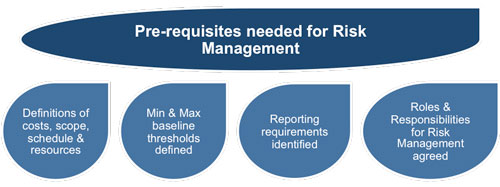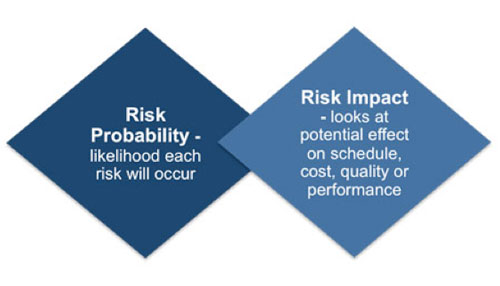
Risk Management Plan Template
This risk management plan template enables you to put together a comprehensive and well-evidenced document as part of your project.
The template guides you through the contents of each section of the plan and ensures that you create a risk log and risk register as appendices. This management plan needs a solid foundation of project data that provides sufficient structure allowing the probability and severity of risks to be quantified. It also requires you to define how you will monitor and report on risks to key individuals within the project environment.
The management and control of risk forms a critical part of any project management, but it cannot be planned for until the project has a degree of structured information on which to base its own management plan. There are four basic aspects that form the foundation required to create this plan.
1) Definitions of costs, work scope, schedule and resources for the project have been agreed and approved.
2) The minimum and maximum baseline thresholds have been defined.
3) Agreement on baseline reporting format, frequency and circulation.
4) Roles and responsibilities of the risk management team have been agreed

Probability and Impact Matrix
The risk management plan and its associated documents (risk log and risk register) form some of the most critical tools for a project manager. It is only by careful identification and weighting of risks that could affect his or her project that they can prepare and plan for what to do if they occur. When a project manager has a clear and concise understanding of the most probable risk he or she can work with others to plan how to alleviate the expected impact and severity on their project.
There are various tools that can be used when identifying potential risks to a project. It is essential that all interested parties understand the difference between the probability of a risk occurring and its likely impact on the project if it does become a reality.

Probability and Impact Matrix
At the start of this exercise it is vital that you recognize who the experts are you should, as project manager, involve in the identification of potential risks. These individuals will come from a variety of sources including your own senior managers, subject matter experts and project stakeholders. Another excellent source of possible risks your project could face can be gleaned from historical project data and reviews.
It is therefore no surprise that meetings form a key tool in this process and a project manager’s success in risk management will depend on his or her ability to manage this collective decision making activity. The importance of being able to set an effective meeting agenda and perform the role of ‘chair’ cannot be underestimated. The final technique available is the use of analytical techniques that combine the attitudes of a project’s stakeholders to each risk with the strategic risk exposure to define the overall risk.
This process creates the risk breakdown structure (RBS) a vital document that outlines the structure and procedures to be adopted during the project to manage risk. It lists the defined risk categories for the project and describes how the ‘Probability and Impact matrix’ will be calculated and presented, an example is shown below.

Probability and Impact Matrix
The management plan makes certain that its defined structure is used to methodically identify risks with dependable level of detail. The RBS with its levels of risk provides an easily understood hierarchically representation of the classified risks. It enables stakeholders and other readers of this document to easily distinguish each category and its related subcategories including their causes.
Any changes in the risks associated with a project must be regularly communicated to stakeholders and the project sponsor to ensure that their risk tolerances are up-to-date and the risk management plan defines how, when and who will receive such reports. This plan also describes its own resource requirements and how these will be budgeted for, including the day-to-day risk management and the associated costs incurred if actions need to be taken when a risk is realized.
One of the most critical aspects of the risk management plan is the process and procedures it defines for how the risk team will monitor and respond if required to each of what can be referred to as its ‘major’ risks. These are risks that have been assessed as having both a high or critical level of impact and probability of happening because there is little that can be done to prevent it happening or lessen its impact on the project.

Probability and Impact Matrix
The plans put in place to handle risk response will have previously considered the four basic ways to handle a risk and selected the most appropriate response to guarantee the projects continued success. Many organizations use a scale of 1-100 or 1-1000 to define the level of uncertainty they attach to a specific project. This overall risk score for a project is calculated by averaging all the individual ‘major’ risk scores. If this score offers an acceptable level of risk against the potential gains the management can achieve then the project will progress further in its preparation and planning.
The risk management plan will also outline the likely contingency budget for those identified risk that are most likely to occur so that potential costs for responding to that risk can be included in the overall project budget. Depending of the nature of the project the project manager may want to include in this contingency planning those risks that have the highest impact on the project even though their probability is lower than the previous group.
